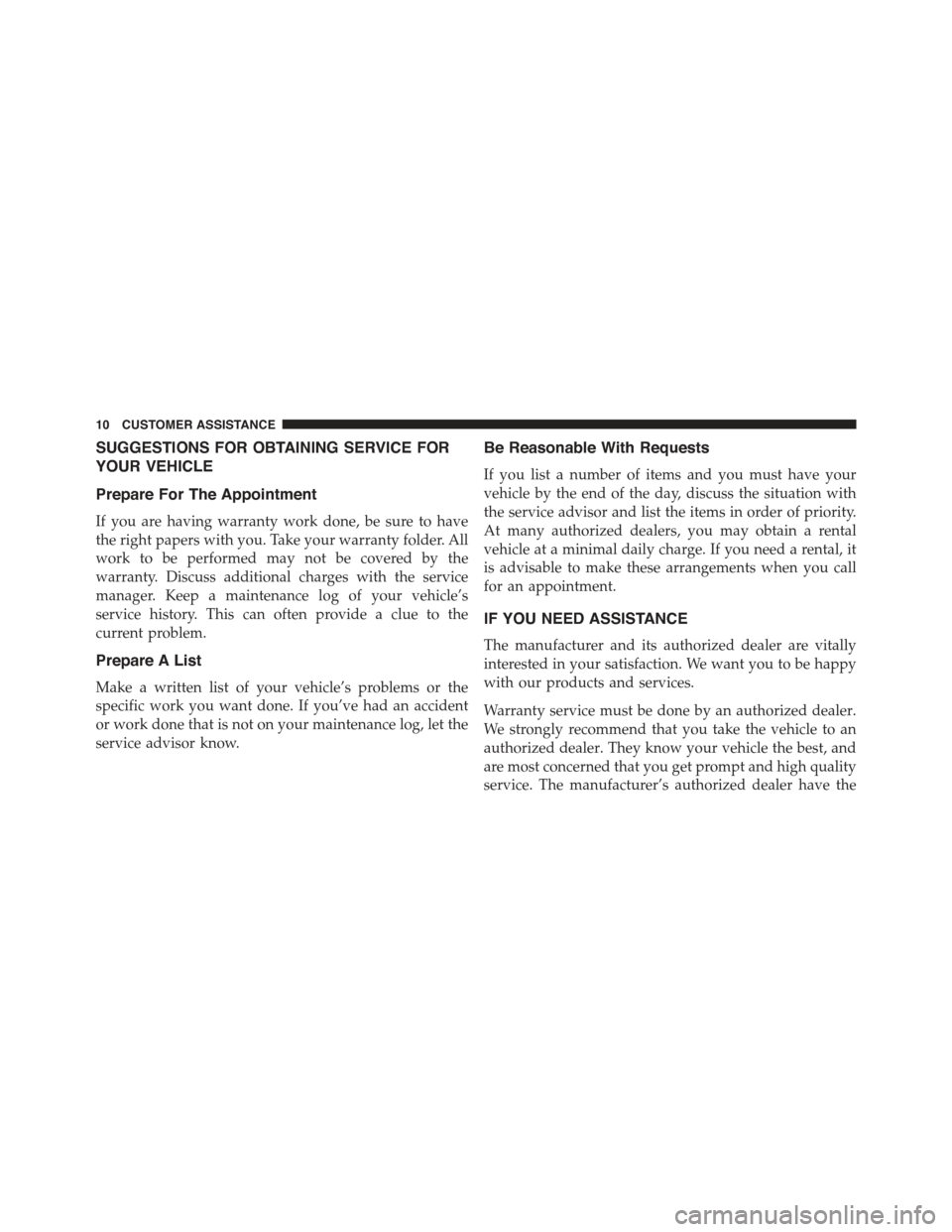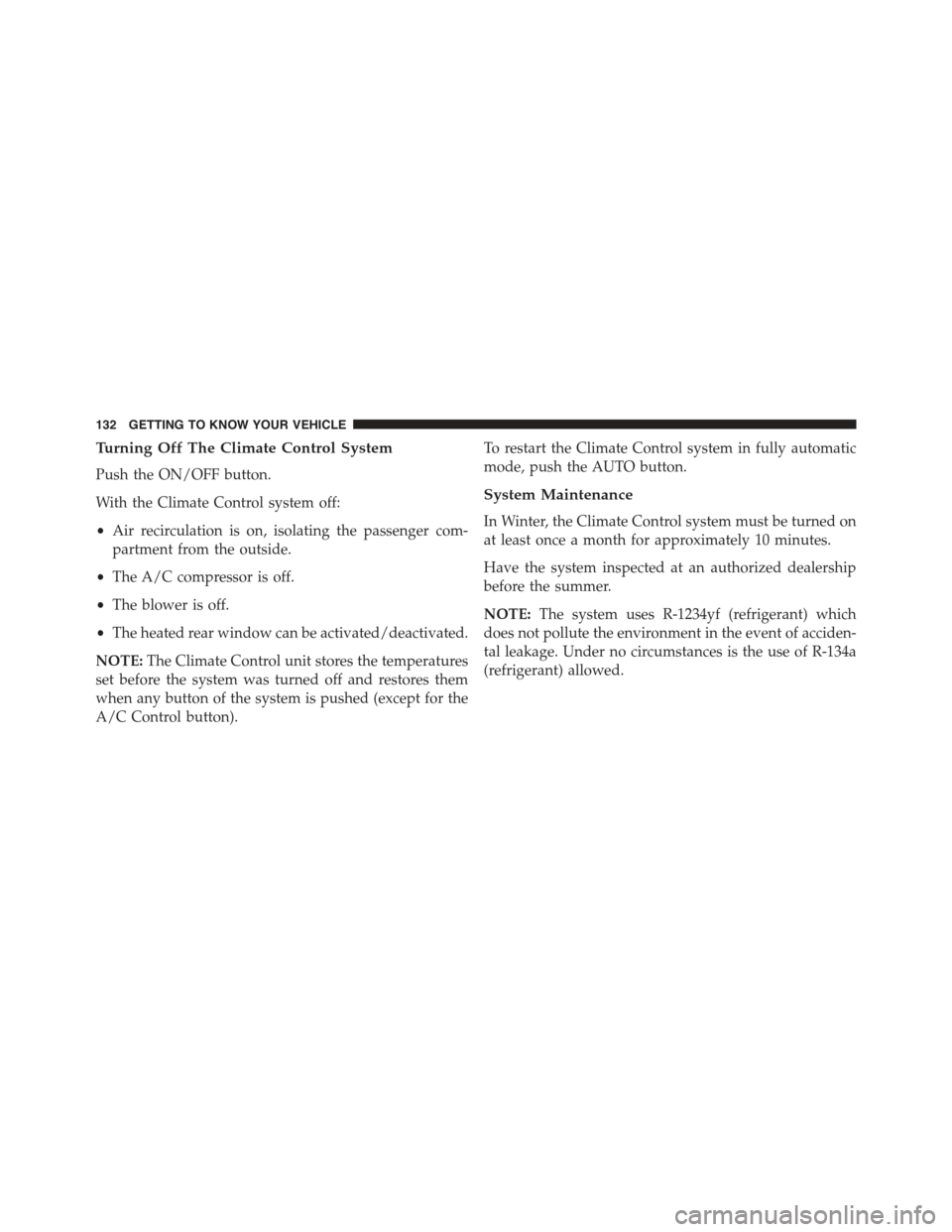2015 JEEP RENEGADE maintenance
[x] Cancel search: maintenancePage 7 of 678

This Owner’s Manual has been prepared with the assis-
tance of service and engineering specialists to acquaint
you with the operation and maintenance of your vehicle.
It is supplemented by Warranty Information, and various
customer-oriented documents. Please take the time to
read these publications carefully. Following the instruc-
tions and recommendations in this manual will help
assure safe and enjoyable operation of your vehicle.
NOTE: After reviewing the owner information, it
should be stored in the vehicle for convenient referenc-
ing and remain with the vehicle when sold.
When it comes to service, remember that your authorized
dealer knows your vehicle best, has factory-trained tech-
nicians and genuine MOPAR® parts, and cares about
your satisfaction.
HOW TO USE THIS MANUAL
Consult the Table of Contents to determine which section
contains the information you desire.
Since the specification of your vehicle depends on the
items of equipment ordered, certain descriptions and
illustrations may differ from your vehicle’s equipment.
The detailed index at the back of this Owner’s Manual
contains a complete listing of all subjects.
Consult the following table for a description of the
symbols that may be used on your vehicle or throughout
this Owner’s Manual:
1
INTRODUCTION 5
Page 12 of 678

SUGGESTIONS FOR OBTAINING SERVICE FOR
YOUR VEHICLE
Prepare For The Appointment
If you are having warranty work done, be sure to have
the right papers with you. Take your warranty folder. All
work to be performed may not be covered by the
warranty. Discuss additional charges with the service
manager. Keep a maintenance log of your vehicle’s
service history. This can often provide a clue to the
current problem.
Prepare A List
Make a written list of your vehicle’s problems or the
specific work you want done. If you’ve had an accident
or work done that is not on your maintenance log, let the
service advisor know.
Be Reasonable With Requests
If you list a number of items and you must have your
vehicle by the end of the day, discuss the situation with
the service advisor and list the items in order of priority.
At many authorized dealers, you may obtain a rental
vehicle at a minimal daily charge. If you need a rental, it
is advisable to make these arrangements when you call
for an appointment.
IF YOU NEED ASSISTANCE
The manufacturer and its authorized dealer are vitally
interested in your satisfaction. We want you to be happy
with our products and services.
Warranty service must be done by an authorized dealer.
We strongly recommend that you take the vehicle to an
authorized dealer. They know your vehicle the best, and
are most concerned that you get prompt and high quality
service. The manufacturer’s authorized dealer have the
10 CUSTOMER ASSISTANCE
Page 120 of 678

Activation of this function is indicated by the rear defrost
indicator light on the instrument panel turning on. The
function is automatically deactivated after 20 minutes.
If equipped, push the rear defrost button to activate the
defrosting of door mirrors and heated rear window.
CAUTION!
To avoid causing damage to the rear window de-
froster heating filaments do not affix stickers or other
objects to the inside of the rear glass.
Air Recirculation
Push and release the Air Recirculation button so that the
LED is on, to enter recirculation mode. It is recommended
to turn the internal air recirculation on while standing in
traffic or in tunnels to prevent the introduction of pol-
luted air.
Do not use the function for a long period of time,
particularly if there are many passengers in the vehicle,
to prevent the windows from misting up.
NOTE:Internal air recirculation makes it possible to reach
the required heating or cooling conditions quickly depend-
ing on the mode selected. Do not use the internal air
recirculation function on rainy/cold days as it would con-
siderably increase the possibility of the windows misting.
System Maintenance
In Winter, the Climate Control system must be turned on
at least once a month for approximately 10 minutes.
Have the system inspected at an authorized dealership
before the summer.
NOTE:The system uses R-1234yf (refrigerant) which
does not pollute the environment in the event of acciden-
tal leakage. Under no circumstances is the use of R-134a
(refrigerant) allowed.
11 8 G E T T I N G TO K N O W Y O U R V E H I C L E
Page 134 of 678

Turning Off The Climate Control System
Push the ON/OFF button.
With the Climate Control system off:
•Air recirculation is on, isolating the passenger com-
partment from the outside.
•The A/C compressor is off.
•The blower is off.
•The heated rear window can be activated/deactivated.
NOTE:The Climate Control unit stores the temperatures
set before the system was turned off and restores them
when any button of the system is pushed (except for the
A/C Control button).
To restart the Climate Control system in fully automatic
mode, push the AUTO button.
System Maintenance
In Winter, the Climate Control system must be turned on
at least once a month for approximately 10 minutes.
Have the system inspected at an authorized dealership
before the summer.
NOTE:The system uses R-1234yf (refrigerant) which
does not pollute the environment in the event of acciden-
tal leakage. Under no circumstances is the use of R-134a
(refrigerant) allowed.
132 GETTING TO KNOW YOUR VEHICLE
Page 191 of 678

proper pressure. Driving on a significantly under-
inflated tire causes the tire to overheat and can lead to
tire failure. Under-inflation also reduces fuel effi-
ciency and tire tread life, and may affect the vehicle’s
handling and stopping ability.
Please note that the TPMS is not a substitute for
proper tire maintenance, and it is the driver ’s respon-
sibility to maintain correct tire pressure, even if
under-inflation has not reached the level to trigger
illumination of the TPMS low tire pressure telltale.
Your vehicle has also been equipped with a TPMS
malfunction indicator to indicate when the system is
not operating properly. The TPMS malfunction indi-
cator is combined with the low tire pressure telltale.
When the system detects a malfunction, the telltale
will flash for approximately one minute and then
remain continuously illuminated. This sequence will
continue upon subsequent vehicle start-ups as long
as the malfunction exists. When the malfunction
indicator is illuminated, the system may not be able
to detect or signal low tire pressure as intended.
TPMS malfunctions may occur for a variety of rea-
sons, including the installation of replacement or
alternate tires or wheels on the vehicle that prevent
the TPMS from functioning properly. Always check
the TPMS malfunction telltale after replacing one or
more tires or wheels on your vehicle, to ensure that
the replacement or alternate tires and wheels allow
the TPMS to continue to function properly.
CAUTION!
The TPMS has been optimized for the original
equipment tires and wheels. TPMS pressures and
warning have been established for the tire size
(Continued)
5
GETTING TO KNOW YOUR INSTRUMENT PANEL 189
Page 218 of 678

•Buzzer Volume
•Maintenance Brakes (If Equipped): activation of the
procedure to carry out braking system maintenance
•Auto Park Brake (If Equipped): enable/disable auto-
insertion of the Electric Parking Brake
$Lights$
By selecting the item#Lights,#you can make the follow-
ing adjustments:
•Headlight Off Delay: set the delay for headlight shut-
off after engine shutoff
•Lights in the opening: activate the direction indicators
when opening the doors
•Headlight Sensor: adjust the sensitivity of headlight
brightness
•Auto. High Beam: activate/deactivate the automatic
main beam headlights (If Equipped)
•Daytime Lights: activate/deactivate the daytime run-
ning lights
•Cornering lights: activate/deactivate the cornering
lights (If Equipped)
$Doors & Safety$
By selecting the item#Doors & Safety,#you can make the
following adjustments:
•Auto Door Lock: activate/deactivate the automatic
locking of the doors with the vehicle moving
•Auto Unlock On Exit: automatic unlocking of the
doors when exiting the vehicle
•Flash Light with Lock: activate the direction indicators
when closing the doors
216 GETTING TO KNOW YOUR INSTRUMENT PANEL
Page 285 of 678

Air Bag Warning Light
The air bags must be ready to inflate for your protection
in a collision. The Occupant Restraint Control-
ler (ORC) monitors the internal circuits and
interconnecting wiring associated with air bag
system electrical components.
The ORC monitors the readiness of the electronic parts of
the air bag system whenever the ignition switch is in the
START or ON/RUN position. If the ignition switch is in
the OFF position the air bag system is not on and the air
bags will not inflate.
The ORC contains a backup power supply system that
may deploy the air bags even if the battery loses power or
it becomes disconnected prior to deployment.
The ORC turns on the Air Bag Warning Light in the
instrument panel for approximately four to eight seconds
for a self-check when the ignition switch is first turned to
the ON/RUN position. After the self-check, the Air Bag
Warning Light will turn off. If the ORC detects a mal-
function in any part of the system, it turns on the Air Bag
Warning Light, either momentarily or continuously. A
single chime will sound to alert you if the light comes on
again after initial startup.
The ORC also includes diagnostics that will illuminate
the instrument panel Air Bag Warning Light if a malfunc-
tion is detected that could affect the air bag system. The
diagnostics also record the nature of the malfunction.
While the air bag system is designed to be maintenance
free, if any of the following occurs, have an authorized
dealer service the air bag system immediately.
•The Air Bag Warning Light does not come on during
the four to eight seconds when the ignition switch is
first turned to the ON/RUN position.
•The Air Bag Warning Light remains on after the four to
eight-second interval.
6
SAFETY 283
Page 320 of 678

▫Maintenance........................396
!ADDING FUEL........................396
!VEHICLE LOADING....................400
▫Certification Label....................400
!ON-ROAD DRIVING TIPS................402
!OFF-ROAD DRIVING TIPS................403
▫When To Use 4WD LOW Range...........403
▫Driving Through Water.................403
▫Driving In Snow, Mud And Sand..........404
▫Hill Climbing........................404
▫Traction Downhill.....................405
▫After Driving Off-Road.................406
!POWER STEERING.....................407
!TRAILER TOWING.....................408
▫Common Towing Definitions.............409
▫Trailer Hitch Classification...............412
▫Trailer Towing Weights (Maximum Trailer Weight
Ratings)............................413
▫Trailer And Tongue Weight..............413
▫Towing Requirements..................415
▫Towing Tips.........................420
!RECREATIONAL TOWING................422
▫Towing This Vehicle Behind Another Vehicle . .422
▫Recreational Towing....................423
318 STARTING AND OPERATING